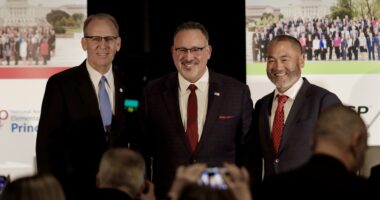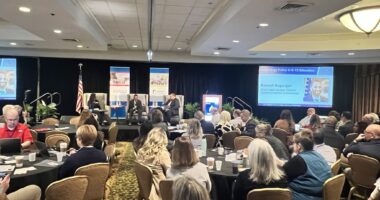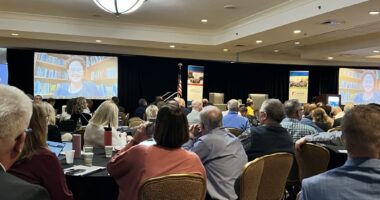Who’s Taking Care of the Principal?
Principals share strategies for finding a support system, establishing healthy habits, and navigating mental health challenges as school leaders.

Leading learning communities amid a global pandemic has proven to be incredibly challenging. School leaders have prioritized their students and staff and pivoted their practices time and again to meet new and emerging needs in their school communities. They’ve navigated these changes with a focus on student learning and safety, family engagement, and staff morale, but lack of funding and resources have led to an inevitable mental health crisis that schools—at no fault of their own—are woefully underequipped to handle.
It seems that everywhere you look these days, from news outlets to social media, there are stories of teacher shortages, mental health crises, and unfinished learning. Strategies often focus on how to better support teachers and students in overcoming these challenges. But it’s imperative that we offer support to principals and assistant principals, who are not immune to these same challenges as they help school communities rebuild and recover.
Listening to Principals’ Stories
For National Principals Month, NAESP focused on principal wellness because it’s such an urgent need for our members. Two events—a policy briefing and an #NAESPchat on Twitter—highlighted the principal perspective on the issue and brought together school leaders to share their stories. Common themes emerged from the two events, where principals shared how they’re doing, where they go for support, how they focus on wellness, and advice they’d give early career principals who are navigating a rapidly changing education landscape.
During the policy briefing, a panel of school leaders discussed challenges administrators are facing in their schools. Among discussion of alarming trends in student suicide and self-harm and the need for district-level programs to support principal well-being, moderator Denisa Superville, from Education Week, asked a question of the panelists: How are you?
“I’m typically happy-go-lucky, smile-on-my-face, glass is overflowing, and it hit me,” said Ed Cosentino, principal of Clemens Crossing Elementary School in Maryland and an NAESP board member, during the briefing. “I got to the point where I had to say, ‘I’m turning off notifications. I’m putting my work cellphone down. I’m not opening up my laptop.’ I set up some pretty big boundaries. Luckily, a year later, I feel like there’s a sense of normalcy.”
Cosentino isn’t alone. Not by a long shot. A recent RAND Corp. report showed that 85 percent of principals reported experiencing job-related stress. By comparison, only 35 percent of working adults outside of the education field reported experiencing job-related stress. Those statistics are sobering, but they’re exactly why principal wellbeing and support must be a priority.
Finding Peer Support
With school leaders focused on helping their students, staff, and communities, it’s important to ask: Who’s actually taking care of the principal?
“In Prince William County, we do have a mentoring program for new principals where they’re paired up with a veteran principal,” said Sue Danielson, principal of Rosa Parks Elementary School in Virginia, during the briefing. “But it is principals taking care of principals. It’s not outside folks taking care of us. It’s us taking care of us because we know the importance of supporting one another.”
Posed to #NAESPchat participants, this question garnered similar responses. Leaning on each other—and family—has been crucial.
“Been getting a lot of support from my colleagues in NAESP and [the Michigan Elementary and Middle School Principals Association]. Also lifted up by my teammates in the Livonia School District, especially my assistant principal,” said Jonathon Wennstrom.
“I have an amazing school resource officer who can sense when I’m in need of support, rest, or prayer. I also have a spouse that picks up the slack at home and helps me handle stress,” said Jeannette Hallam.
Prioritizing Self-Care
In the policy briefing, Danielson said something that resonated with the other panelists: “Self-care isn’t selfish.” That’s an emerging theme as principals are increasingly encouraged to put the focus back on their wellbeing.
We asked participants of the #NAESPchat what habits and routine they’ve incorporated into their wellness journeys, and they highlighted self-care practices that support their physical and mental health and give them a sense of gratitude even when times are tough.
“I read, [do] yoga, and work out all before my day begins. It’s what works best for me and an investment I need to be my best self,” said Abe Rivera.
“At the end of the night, I think back to three things that made me smile during the day. It’s easy to focus on the stressful parts, but it’s important to remember the little things that went well: a high-five, a thank you, a ‘Hi, Ms. Falasco’ all make it worth it,” says Tara Falasco.
Building Connections as New Principals
Connection is so important in any wellness journey, especially in the principalship.
“We need more time for principals to collaborate,” Cosentino said during the briefing. “We need veteran principals helping out new principals and … new principals helping out veteran principals with their energy and innovation. By collaborating and networking, you can make it much easier so that you’re not alone and doing it by yourself.”
In that vein, we asked during the #NAESPchat what advice veteran principals would give to those early in their career about wellness and self-care?
“Don’t think you have to have all the answers; lean on your people. Do something that fuels your soul every day (dance with students, have a personal conversation with teachers). No email after 8 or 9 p.m., and turn off all notifications on your phone,” said Allyson Apsey.
“Invest in you first. You’ll be better for it, and those you serve will reap the benefits of your investment. Let go of any guilt you will experience when doing so,” said Rivera.
“Once you give away your ‘wellness time’ to some other task or commitment, it’s hard to claim it back. Keep it as a priority,” said Hallam.
To gain more insight into principals’ perspectives on wellness, watch the policy briefing. Looking to build connections? Check out the NAESP Communities of Practice.
Krysia Gabenski is the digital communication associate at NAESP.




